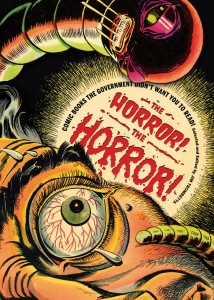Book reopens horror pages of the 1950s
Terror! Voodoo! Suspense!
When people think of comic books, those words aren’t usually the first that come to mind. Instead, people tend to picture superheroes. And although superheroes are the dominant topic of American comic books, they are not the only ones.
At the dawn of the 1950s, horror was all the rage.
As World War II ended, the ever-growing superhero genre suddenly stagnated. In its place, the market turned toward the horror genre. The horror boom was short-lived, however, as government censorship quickly killed it. The Horror! The Horror!: Comic Books the Government Didn’t Want You to Read! is an attempt to preserve and showcase these lost works.
Selected and edited by Jim Trombetta, The Horror! The Horror! is a hybrid between a comic book collection and a history book. Featuring covers and excerpts from popular horror books from EC Comics (the publisher behind Tales from the Crypt!) and other companies, the book covers a wide range of spooky topics.
Beside the comic excerpts, the book details the rise of censorship in the comic book industry. Fueled by Frederic Wertham’s infamous book The Seduction of the Innocent — a book that denounced the entire comic book medium as promoting delinquency — Congress created The Comics Code Authority in 1954, a censorship program that nearly destroyed comics entirely.
The CCA was an independent organization that quickly put the kibosh on intense violence, supernatural elements, depictions of graphic crime and scary stories — the staples of the horror genre.
In eerie detail, Trombetta lays out the growing argument against comics, showing the movement’s increasing popularity side by side with the evolving storytelling in the horror genre.
What makes The Horror! The Horror! so enjoyable is its ability to transport the reader back to the early ’50s. It doesn’t make the decade feel like a Leave It to Beaver episode but instead gives the reader an impression of the cultural fears, and lifestyle of the time.
Amid all of the horror in the comic books themselves, Trombetta highlights the anxieties of the people: fears of atomic warfare and communist threats, a desire to keep their children safe in a scary time. It was amid these fears that censorship took hold, and although it sounds quite silly now, the book gives a Bradbury-esque overtone to the real-life movement.
Trombetta chooses his material carefully. Alongside the history of the genre and its censorship, he adds breakdowns of popular horror topics, such as werewolves, skeletons and brainwashing. These in-depth chapters are short but entertaining, adding cultural context to the spooks in the panels.
For instance, the start of the Korean War saw a rise in stories about brainwashing, as the public feared American prisoners of war might come home with implanted thoughts from the North Koreans and Chinese. The Manchurian Candidate wasn’t the first story to use that fear as a plot point.
The comics themselves are a real treat. Although they might seem a little campy and timid compared to the torture-porn genre that many people now consider horror, the stories work as intriguing parables on the Cold War and the 1950s.
The included comics are split between excerpts and covers, but they work as both stories and as pictures. The comic book covers — published here on high quality paper with great color, as opposed to their pulpy original pressings — are detailed, entertaining works of art. Imagine a cross between pop art and a vintage horror movie poster — that’s one of the many covers in the book.
The art is a high point of the book. Before they really took off in the 1960s, numerous famous comic book artists tried their hand at horror stories. The Horror! The Horror! features the visually appealing early works of Alex Toth (the man who designed Space Ghost — back when he was an action hero and not a talk show host) and Steve Ditko (co-creator of Spider-Man and Doctor Strange) among others.
As an added bonus, the book includes a DVD with Confidential File, an early television show from the ’50s focusing on the “evils” of comics. It’s a great supplement to the book, helping to establish the cultural trends of the time. The show’s silly premise, complete with completely serious “experts,” makes it a perfect, unintentional comedy for the topic, much as how Reefer Madness became popular among the drug users it was trying to condemn.
The book is not a complete history of the rise of censorship in the 1950s, and it’s not a horror fan’s dream collection of vintage spooky comics. Still, The Horror! The Horror! is a great achievement in explaining a cultural fear, giving context to the sources and the reactions. For anyone looking for some old fashioned chills or an interesting bit of history, this is the book to get — especially with Halloween right around the corner.

